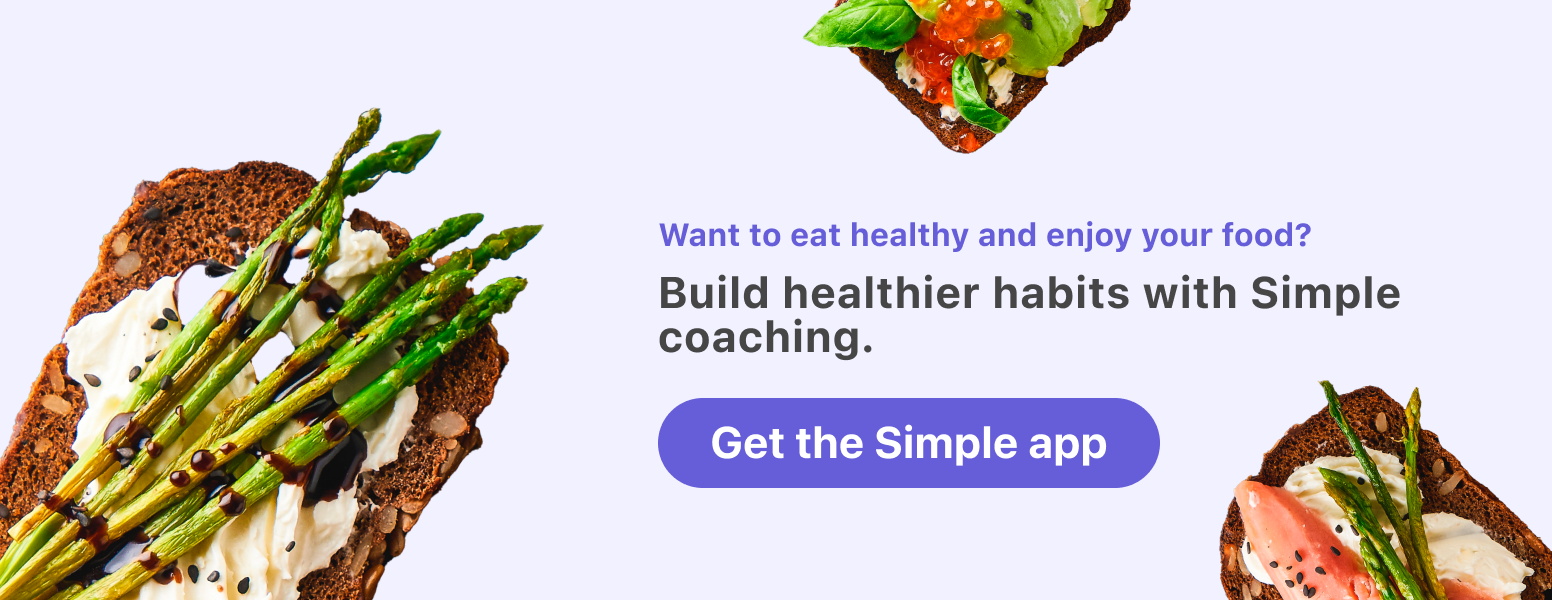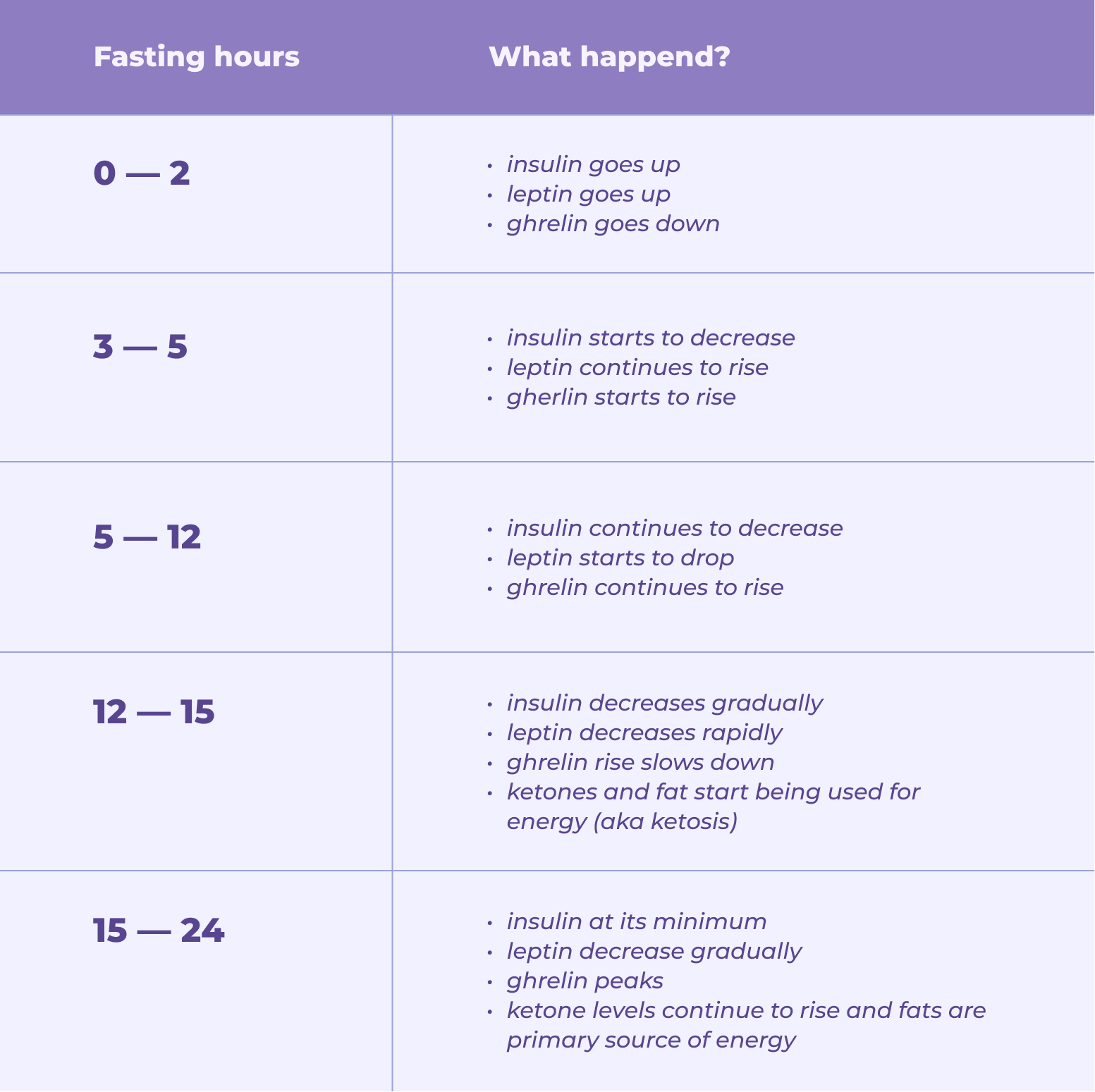Intermittent fasting benefits by the hour

Intermittent fasting involves a repeated cycle of eating windows (where you consume the calories and nutrients you need for the day) and fasting windows (where you take a break from consuming calories).
There are many different ways to fast — from time-restricted approaches like intermittent fasting 16:8 to off / on approaches like the 5:2 diet, alternate day fasting, and eat stop eat — but how does an intermittent fasting timeline actually play out in your body? What sort of fasting benefits timeline can you expect — is there a fasting chart by the hour guidebook out there?

From fed to fasted, let’s explore the intermittent fasting benefits by the hour and what fasting actually looks like, inside out — plus how to supercharge eating windows.
Need Intermittent Fasting 101 first? Check out our intermittent fasting for beginners guide.

Benefits of intermittent fasting by hour
We know little is more low-key annoying than getting to the end of a really good proposition and discovering there’s dealbreaker fine print.
So, let’s get some disclaimers out of the way.
When it comes to fasting, everyone responds differently. So, while the hourly benefits of fasting follow a general timescale, these numbers aren’t exact or universal. There’s no fasting by the hour roadmap that applies to every body and every fast in exactly the same way.
Think of it like Google Maps: sure, it gives you a rough idea of timing from A to B, but maybe you’re an extra fast walker, or there’s unexpected traffic ahead.
Similarly, “more” isn’t necessarily “better” — a longer fast doesn’t automatically translate to better results. It’s about finding your optimal fasting period where you unlock benefits without sacrificing your well-being.
The winding route versus the straight shot still gets you to the same place eventually, and one involves more fuel and planning …
Keeping those caveats in mind, here’s roughly what to expect in terms of fasting benefits by the hour.

0 to 2 hours
The first few hours post eating are focused on turning food into helpful body stuff, like energy, fat, muscle, and brain power. This process is powered by insulin,[1] a hormone that transports sugar from your blood to your cells, so insulin levels increase (though how much depends on your meal and your insulin sensitivity levels [2]). Simultaneously, the levels of a hunger-stimulating hormone, ghrelin,[3] decrease while those of an appetite-suppressing hormone, leptin,[4] increase.
3 to 5 hours
After your body spends some hours digesting and distributing everything, it chills in a post-absorptive state (basically digestive sleepy time). Your insulin levels drop, and your body starts converting the extra sugar it stored from the meal into energy. Levels of human growth hormone (which plays a role in regulating metabolic functions, like burning fat [5]) may start to increase.[6]
5 to 12 hours
Once your body runs out of sugar, your insulin levels drop, and your body starts breaking down fat cells to use as fuel. This process, lipolysis,[7] is a crucial part of reaching ketosis (a metabolic state where your body starts burning fat as energy, which is helpful for things like weight loss). As a result, your body will start to produce ketones, which are used for fuel.
12 to 15 hours
Now things really start to heat up. This time period is likely when you’ll hit your ketone-producing peak rate, which means you’re now most likely in ketosis.
15 to 24 hours
By now, your body is likely using fat as its main fuel source, with ketones as a close second. That means you’re getting into the full swing of fat-burning mode. Most research on time-restricted eating uses fasts up to 16 or 18 hours and suggests fasting for this amount of time is enough to reap the weight loss and metabolic benefits. While some studies focused on longer fasting windows have demonstrated promising results, too,[8] we don’t think they’re necessary, and we don’t recommend fasts beyond 18 hours unless you have medical sign-off. Although rare in people without diabetes, an 18+ hour fast can be dangerous and lead to life-threatening conditions like ketoacidosis.[9] Longer fasts may also make it harder to get in all the nutrients our body needs and loves.
24 to 36 hours
Here is when you may also start experiencing autophagy — when your body starts flushing old / damaged cellular material and regenerating healthier, fresher material. While autophagy is broadly accepted as a healthy aging hallmark, there are still a lot of questions about how the process works,[10] how it helps,[11] and how we can use it.[12] Plus, everyone’s metabolism and fasting responses are different, so you can’t consult a fasting hours chart and know exactly when you’ll ascend into your autophagy era.
It’s also important to bear in mind that it’s not possible to study autophagy properly in humans (existing data comes from animal studies), so we still have a ways to go before we can prove these benefits translate to humans. That’s why we don’t recommend such long fasts, even if you’re used to long fasting days, at least without medical sign-off, for anti-aging benefits just yet. But we’re excited to see where the research takes us.
Possible side effects by hour
Just as your fasting benefits experience is one-of-a-kind, so too is your journey with intermittent fasting side effects. Maybe your fasting by the hour chart has one or two in store for you; maybe it has a basketful. Maybe they’re short-lived; maybe they’re persistent.
Regardless, you likely won’t hit major bumps during the first couple hours of a fast since you’re used to a few hours without food. Beyond that, some early-stage side effects may include:
- hunger / cravings
- headaches
- lightheadedness
- fatigue
- irritability
- poor sleep
- low blood sugar
- digestive issues
These side effects may get more severe the longer you fast and may evolve into more serious or long-term side effects (like malnutrition or hormonal changes) if left unchecked. If any of these side effects persist, make sure to see your healthcare provider, and if any of them are severe or unbearable, you should also stop fasting immediately.

Other common benefits of intermittent fasting
Rome wasn’t built in a day, nor are safe, sustainable results. Beyond the fasting effects by hour you may experience, longer-term intermittent fasting benefits may include:
- reducing inflammation and inflammatory diseases [13]
- losing weight and maintaining weight [14,15]
- supporting heart health [16]
- promoting healthy brain aging [17]
- lowering systolic blood pressure [18]
- increasing metabolic rate (ensuring intermittent fasting doesn’t slow metabolism) [19]
- lowering the risk of type 2 diabetes (by reducing insulin resistance, improving insulin sensitivity, and decreasing cholesterol and blood glucose levels) [20,21]
What your fasting benefits chart features is up to your body, and fasting isn’t effective or right for everyone. We recommend getting your fasting plan signed off by your healthcare provider before changing your eating pattern, especially if you:
- are pregnant, breastfeeding, or trying to conceive
- have a history of or are currently experiencing disordered eating
- have a medical condition, especially those that impact the pancreas, liver, thyroid, or gallbladder
- have a BMI less than 18.5
- are under the age of 18, or 80 years old or more
- are prescribed medication
If you’ve been given the green light, we’re here to rev you up, keep you going, and get you across your fasting finish line. Take our Simple quiz to learn what fasting schedule might be a good fit for you and your end game.
Fasting hour-by-hour meal plan

It’s true: what to eat during intermittent fasting is entirely up to you. You can have your cake and eat it, too (literally!).
That said, fasting and then eating bottomless buckets of wings chased with a plateful of brownies sadly won’t give you the best results (especially if you’re aiming for weight loss).
To power up your fasting timeline benefits, choose health-promoting foods that provide fiber, protein, slow-releasing carbs, and essential nutrients to curb hunger, keep your digestive system happy, and maintain stable blood sugar. Build your eating windows (and calorie intake) around fruits, veggies, whole grains, lean protein, and healthy fats like:
- eggs (a particularly great choice for your first meal!) [22]
- turkey chili over brown rice
- bean and lentil curry
- grilled salmon with roasted broccoli
- oats with berries and a spoonful of nut butter
Staying hydrated throughout your fast is also super important. (Here are our tips on what you can drink while fasting.)
Especially if you’re fasting to manage weight, we also recommend limiting foods that are either ultra-processed or high in trans / saturated fat and refined carbohydrates, as they can incite cravings, spike your blood sugar, and max out your caloric intake with limited nutrients.
To separate fasting foes and frenemies, you can also plan your eating windows with our how to meal plan advice.

Every body responds to fasting differently, so there isn’t a universal ranking system of which fasting schedules are better than others. To figure out “is a 12-hour fast better than 16 hours” for you, factor in your needs, goals, preferences, and lifestyle. (You can also take our Simple quiz!)
Whether 14 hours is enough for intermittent fasting depends on why you’re fasting in the first place and how your body responds to the process. Not sure your intermittent fasting hours chart is lining up? Check out our “intermittent fasting not working” troubleshooting guide.
Asking, “What diseases does fasting cure?” is kinda like asking, “Why does chocolate make people happy?” — it’s getting a little ahead of the game and assuming causation and universality. Fasting may be helpful in managing and treating type 2 diabetes, preventing aging-related diseases, and improving cardiometabolic risk factors, but it’s not a guaranteed, universal outcome.[16,20,23]
- Wilcox G. Insulin and insulin resistance. Clin Biochem Rev. 2005 May;26(2):19–39.
- Yari Z, Behrouz V, Zand H, Pourvali K. New Insight into Diabetes Management: From Glycemic Index to Dietary Insulin Index. Curr Diabetes Rev. 2020;16(4):293–300.
- Ibrahim Abdalla MM. Ghrelin – Physiological Functions and Regulation. Eur Endocrinol. 2015 Aug;11(2):90–5.
- Dornbush S, Aeddula NR. Physiology, Leptin. StatPearls Publishing; 2023.
- Sanvictores T, Casale J, Huecker MR. Physiology, Fasting. StatPearls Publishing; 2022.
- Goldenberg N, Horowitz JF, Gorgey A, Sakharova A, Barkan AL. Role of pulsatile growth hormone (GH) secretion in the regulation of lipolysis in fasting humans. Clin Diabetes Endocrinol. 2022 Feb 1;8(1):1.
- Edwards M, Mohiuddin SS. Biochemistry, Lipolysis. StatPearls Publishing; 2022.
- Tinsley GM, La Bounty PM. Effects of intermittent fasting on body composition and clinical health markers in humans. Nutr Rev. 2015 Oct;73(10):661–74.
- Ghimire P, Dhamoon AS. Ketoacidosis. StatPearls Publishing; 2022.
- Glick D, Barth S, Macleod KF. Autophagy: cellular and molecular mechanisms. J Pathol. 2010 May;221(1):3–12.
- Aman Y, Schmauck-Medina T, Hansen M, Morimoto RI, Simon AK, Bjedov I, et al. Autophagy in healthy aging and disease. Nat Aging. 2021 Aug;1(8):634–50.
- Parzych KR, Klionsky DJ. An overview of autophagy: morphology, mechanism, and regulation. Antioxid Redox Signal. 2014 Jan 20;20(3):460–73.
- Wang X, Yang Q, Liao Q, Li M, Zhang P, Santos HO, et al. Effects of intermittent fasting diets on plasma concentrations of inflammatory biomarkers: A systematic review and meta-analysis of randomized controlled trials. Nutrition. 2020 Aug 12;79-80:110974.
- Varady KA, Cienfuegos S, Ezpeleta M, Gabel K. Clinical application of intermittent fasting for weight loss: progress and future directions. Nat Rev Endocrinol. 2022 May;18(5):309–21.
- Ganesan K, Habboush Y, Sultan S. Intermittent Fasting: The Choice for a Healthier Lifestyle. Cureus. 2018 Jul 9;10(7):e2947.
- Yang F, Liu C, Liu X, Pan X, Li X, Tian L, et al. Effect of Epidemic Intermittent Fasting on Cardiometabolic Risk Factors: A Systematic Review and Meta-Analysis of Randomized Controlled Trials. Front Nutr. 2021 Oct 18;8:669325.
- Francis N, George & Anne Ryan Institute for Neuroscience, University of Rhode Island, 130 Flagg Road, Kingston, RI, 02881, US, Department of Psychology, Stony Brook University, 100 Nicolls Rd, Stony Brook, NY, 11794, US. Intermittent fasting and brain health: Efficacy and potential mechanisms of action. OBM Geriatrics. 2020 Jun 1;4(2):1–19.
- Wang W, Wei R, Pan Q, Guo L. Beneficial effect of time-restricted eating on blood pressure: a systematic meta-analysis and meta-regression analysis. Nutr Metab . 2022 Nov 8;19(1):77.
- Adafer R, Messaadi W, Meddahi M, Patey A, Haderbache A, Bayen S, et al. Food Timing, Circadian Rhythm and Chrononutrition: A Systematic Review of Time-Restricted Eating’s Effects on Human Health. Nutrients [Internet]. 2020 Dec 8;12(12).
- Albosta M, Bakke J. Intermittent fasting: is there a role in the treatment of diabetes? A review of the literature and guide for primary care physicians. Clin Diabetes Endocrinol. 2021 Feb 3;7(1):3.
- Yuan X, Wang J, Yang S, Gao M, Cao L, Li X, et al. Effect of Intermittent Fasting Diet on Glucose and Lipid Metabolism and Insulin Resistance in Patients with Impaired Glucose and Lipid Metabolism: A Systematic Review and Meta-Analysis. Int J Endocrinol. 2022 Mar 24;2022:6999907.
- Ratliff J, Leite JO, de Ogburn R, Puglisi MJ, VanHeest J, Fernandez ML. Consuming eggs for breakfast influences plasma glucose and ghrelin, while reducing energy intake during the next 24 hours in adult men. Nutr Res. 2010 Feb;30(2):96–103.
- Mattson MP, Longo VD, Harvie M. Impact of intermittent fasting on health and disease processes. Ageing Res Rev. 2017 Oct;39:46–58.
